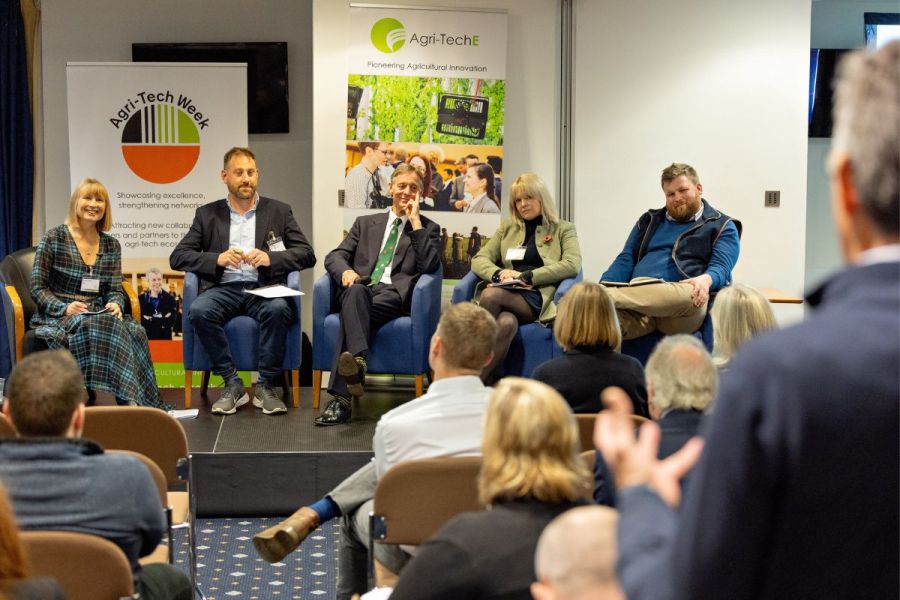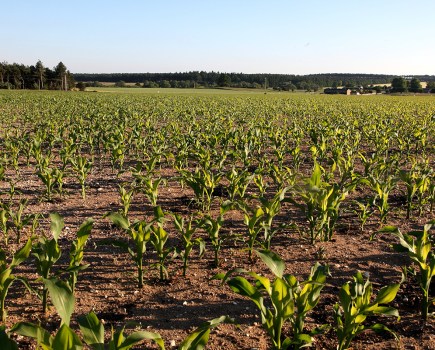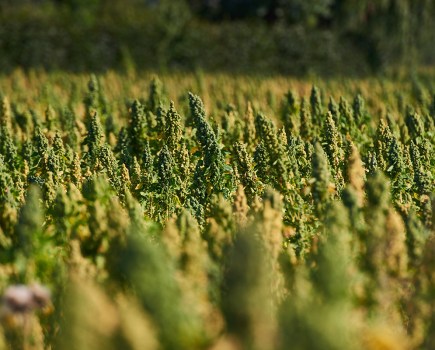How to grow more food while achieving net zero carbon emissions and increasing biodiversity – that was the challenge highlighted at Agri-TechE’s REAP conference at Newmarket Racecourse. CPM joined delegates to find out more.
“We require more science to face the triple challenge of increasing food production, reducing greenhouse gas emissions and reversing the decline in biodiversity.”
By Will Charlton
The REAP conference always attracts prestigious industry leaders to speak. This year, senior figures from DEFRA, the NFU, farming organisations, food processors and retailers discussed the conference theme – adaptation through innovation.
The event is organised by Agri-TechE, which celebrates its tenth anniversary this year, and is a membership organisation that connects researchers, companies and farmers to facilitate the development and adoption of new agricultural technologies.
Undeniably, the agriculture industry of 2024 is almost unrecognisable from 2014. According to Dr Belinda Clarke of Agri-TechE, the explosion in ag tech had only just begun 10 years ago and subjects such as net zero or biodiversity were only starting to be widely discussed.
“Looking back to the first REAP, everyone was excited about drone technology. Since then, the conversation evolved to imaging technology and then to data.
“Data seems to be an intractable challenge. We’re getting some actionable insights from what we have, but there’s far more data being generated than the value being extracted from it. That’s the thing we have to work on as an industry,” she stresses.
As part of its activities, Agri-TechE arranged a member delegation to visit Agritechnica in November. Belinda says she witnessed conversations about interoperability from the companies exhibiting there, although she’s yet to see much delivered.
“Interoperability and extracting insights from data remain the Holy Grail. The tools now available to us, like AI, machine learning and computer vision, mean that I hope we’re coming to an inflexion point in the industry where we won’t struggle to manage data.
“I expect we won’t still be having this conversation about data in the next ten years,” she says.
REAP’s keynote speaker was DEFRA’s chief scientific advisor, Professor Gideon Henderson. To set the scene, he explained that the global population recently reached eight billion, with each person requiring 2,000 calories a day to survive.
“Historically, the increasing population has been fed by utilising more land for food production. However, since the 1960s, science has enabled us to produce more food from the land we grow it on.
“Nitrogen from the Haber-Bosch process and genetic improvements drove that decoupling. Now, we require more science to face the triple challenge of increasing food production, reducing greenhouse gas emissions and reversing the decline in biodiversity,” he explains.
In the UK, 71% of land is farmed, which is an absolute constraint to how the challenge of food production in a changing world is faced, comments Gideon. He believes there are four things that require us to change how we use our land in the future, and three stem from the challenge of driving the UK to net zero by 2050.
“The government is targeting tree planting to reach 30,000ha a year,” says Gideon. “Across several decades, that’ll require 750,000ha of land across the UK, which will be a significant change but not revolutionary, when compared with the 3.25M hectares of woodland that already exists.
“Secondly, the degradation of peatland is destroying soils and releasing large amounts of carbon into the atmosphere. This’ll require us to change how we farm lowland peat, either by rewetting or by growing new crops,” he says.
Gideon then explained that the third policy area which will impact land use is the role of biomass or biofuel. At present, 12% of energy generation in the UK is from burning biomass and although most comes from overseas at the moment, it’s possible to grow more of that in the UK. “These would be crops like miscanthus, willow, short rotation coppice or perennial crops,” he says.
“There’ll also be an increased requirement to create habitats – DEFRA has a specific target to create or restore half a million hectares. This, coupled with the carbon reduction targets, will mean approximately 2M hectares of land changes use to focus on carbon reduction or biodiversity gain. It’s a significant change to the way we farm and use our land.”
It could be argued that a desire by the government and main opposition parties to maintain or increase food production seemingly runs at odds with the land-use changes outlined by Gideon. However, he believes the industry can increase productivity to meet both objectives and key to that will be new technologies.
For example, DEFRA funds the Genetic Improvement Networks (GINs). Their research helps to develop crop varieties with resistance to challenging pests and diseases such as orange wheat blossom midge (OWBM).
“We can take our increased understanding of genetics and use it to precision breed to make better crops quicker and more efficiently. We now have the Precision Breeding Act on the statute books to increase the rate of improved varieties for use in the UK and globally,” says Gideon.
“Furthermore, there are 7,000 edible plant species, but humans only consume 400, with six being staples. We’ll have to look at new crops, particularly on peatland, where there’ll have to be a change in land use.
“Vertical and indoor farming are also areas where we can increase productivity without being bound by land constraints. This can be coupled with the use of aero- and hydroponics to eliminate the use of soil in food production.”
To help support the industry in increasing productivity whilst repurposing the use of some agricultural land, Gideon says DEFRA is providing funding via several different pathways. The Farm Innovation Programme has an industry-led R&D partnership fund which connects groups of farmers and businesses with researchers.
Whereas the Farming Futures R&D fund already provides funding for climate-smart farming, sustainable protein production, automation and robotics, and environmental reliance. In addition, this has plans for future funding calls on precision breeding and carbon.
Also speaking at the conference was David Exwood, vice president of the NFU. In response to Gideon, he says the ever-increasing production and consumption of food can’t be taken for granted. “The land use framework is coming; Gideon shared some of the plans that’ll be in it. But how will it be decided who does what with the land?
“It will be almost impossible to have a top-down approach. Just leaving it to the market to decide doesn’t seem to be right either. So, the industry will have an incredibly complex choice coming up,” says David.
“Whatever the government decides, they’ll have to pull levers to support food production. There are clear environmental targets but much less ambition for food production. Gideon talked about the progress that’s been made on carbon reduction in other industries, but we know a lot of that improvement has been made by moving manufacturing abroad. We can’t do the same with our food production as well.”
That said, David acknowledges available technologies. “The Precision Breeding Bill gained broad political support and something similar is coming in Europe too, which is a sign of the challenge they face. I’ve been farming for 30 years and it’s never been a more exciting time than now. I can pretty much farm my farm through my phone now; I couldn’t do that five years ago,” he says.
Fenland farmer, Tom Clarke, says the Fens makes up 4% of UK farmland area but produces 7% of its food. “If you repurpose that land, where will the food produced on it come from?” he asks.
“It’ll have to be grown on less productive land, and Gideon said we have to increase productivity. It could also be grown abroad in countries where the environmental footprint may not be as verifiable.
“There’s nowhere in the country where the problem of nature versus food production versus carbon emissions is more acute than the Fens. It’s our productive agricultural land, wetlands are the most biodiverse environment that we have in the country, and the very fenland I farm emits carbon dioxide just because it’s dry,” explains Tom.
He says in other parts of the country, there’s an easy solution to land use changes due to marginal land or having an obvious alternative use, whereas lowland peat is much more complicated.
Presenting something different, the start-up showcase is always the most popular session at the REAP conference. Each year, six new companies are given the opportunity to share their technology with delegates. Past alumni include Yagro, Small Robot Company and Breedr.
This year, the spotlight was on PES Technologies, which has developed an in-field portable soil testing system to provide farmers and agronomists with GPS-tracked immediate results. They claim it’ll provide biological, physical, macronutrient and pH results within minutes.
“When we began developing our system, we were told by NIAB that there were no good quality soil health tests that were also affordable, particularly for soil microbiology,” says Dr Jim Bailey. “If we want to restore our soils, we have to be able to measure microbial biomass; 80% of new organic carbon sequestered in soil comes from the microbes.”
Jim explains that the sensors in the system ‘smell’ the soil by using electrical fingerprinting and machine learning in the cloud, with a high degree of accuracy. “The sensors plug into the device using a cassette, which will have enough to do more than 100 tests per cassette.”
Soil samples can be taken in the same way as standard protocols with 5-15cm being the target depth. However, Jim says there are far fewer steps than present sampling techniques, such as packaging and posting the sample and then waiting for a lab to do the test.
The frequency of sampling is up to the farmer or agronomist and results will be aligned with the RB209 indices. However, he explains that soil biology is more complicated because there’s no fixed reference for results.
According to Jim, PES Technologies is developing an index for soil biology results, which will be ready for commercial launch later this year.
Also in the showcase was PlentySense, which has developed a sensor claiming to be the first device to continuously measure nitrogen in the soil. Born from a research project at the John Innes Centre (JIC) to screen different cultivars for nutrient use efficiency, the team realised it had applications beyond research.
Professor Tony Miller from the firm says the sensor delivers real-time in-soil nutrient data to aid decision-making. A solid-state probe, it measures nitrogen through the soil profile meaning it can provide information on overall availability and location.
“It measures soil water nitrate, which is the nitrate level dissolved in soil water. It’s the most meaningful measurement because this is the form that’s available for plant roots to take up and is a different measurement from what you get from soil core and potassium chloride extraction,” he explains.
PlentySense has been collaborating with Agrii by trialling their sensors on their technology farms. “We sent the sensors to Revesby Estate in Lincolnshire, which is a technology farm. They’re used to analysing Agrii trials investigating different nitrogen applications and nutrient use efficiency.
“The PlentySense sensor will allow more precise fertiliser applications by showing a farmer where the nitrogen is in their soil. This is important because globally, more than 50% of the nitrogen applied to crops is wasted. There are a number of measures that will improve this; better understanding the available nitrogen already in the soil is one,” concludes Tony.
For more information about Agri-TechE or the REAP conference, visit www.agri-tech-e.co.uk
This article was taken from the latest issue of CPM. For more articles like this, subscribe here.
Sign up for Crop Production Magazine’s FREE e-newsletter here.




